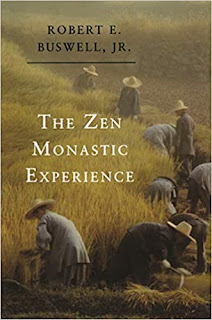| Fairies (mystic devas, "shining ones") are ETs or extradimensionals of Celtic and Irish lore. |
 |
| Irish "Divine Tribe of Danu" with Reptilian Naga |
The deva or "shining one" Lord Shiva said he
came from a rocky planet and brought some of it.
COMMENTARY: Korean Zen
 |
| Bhante, why do you suppose this was built with tons of stone in ancient times? - To look nice? |
.
 |
| The Zen Monastic Experience (Robert E. Buswell) |
Long ago, our UCLA Professor of Buddhism Dr. Robert E. Buswell, Jr. told the class an amazing story. He had been a Zen monk in Korea (at Songgwang-sa, Cholla Namdo), living an austere life, and a Theravada Thai Buddhist monk in Thailand then disrobed and went on to become a doctoral student and professor. He detailed the long hours of meditation sesshins, how little they ate, how they slept on straw mats in the hall, which were then rolled up for a day of sitting zazen. It was the real thing, not our silly notions of Zen as wandering about navel gazing and pondering koans. One day he was surprised that to break the monotony of this season of intensive practice, when half of the monks went on extra duty cooking, warming, cleaning, and providing support, and the other half did nothing but meditate. Perhaps not understanding Korean as fluidly as he would go on to do, the monks were laughing -- if memory serves, and memory of old college lectures is not the most reliable source of information -- as they attempted to stick a straw from the broom in his scalp. Why? There was nowhere for it to go. He tried many times. They all smiled or laughed.
- Zen austerities during sesshin included these things that left us rapt in class, particularly one aspiring Angeleno wanting nothing more than to move to India and become an extreme ascetic to gain the path and win enlightenment right away:
- They would wake up at 3:00 or 4:00 in morning
- Go to a water pump, dip two fingers in salt to brush their teeth
- Go sit on reed mats and stiff cushions for the morning sit
- Eat a meal of boiled rice, daikon radish they grew, a slice of ginger, and if they were lucky a sprinkle of sesame seed
- Then go to meditate more, for 18 hours a day
- If someone started to nod off, the Zen master might bring out swords for meditators to lean their chins on (and no one would ever fall asleep)
- It was cold outside, and the zendo was warmed from the wooden floor by some creative technology from the kitchen or furnace room circulating heat under the boards.
- Sesshin is, of course, an intensive, so it wasn't always like this. During the rest of the year they might chop wood, carry water, grow vegetables (mainly daikon), go on alms, rake leaves, and be mindful all day long.
- (Prof. Buswell's great insight was that the Zen monastic experience is not a bunch of iconoclastic Beat poets sitting around, drinking tea, puffing pipes, writing haiku, pondering koans, and playing the flute under cherry blossom trees. They were all very learned in the texts and other studies and were in this monastery to practice beyond words. As Americans we think Zen is the easiest of all the Buddhisms because it's just "whatever," anything we want it to be. But that is not how it is in serious Asia, where this tradition is the way of "meditation" (which is what jhana, dhyana, Chan, and Zen, or Seon in Korean, mean). So with all this meditating, it's no wonder one would be more sensitive to subtle energies and architectural emanations:
 |
| Famous Sanchi Stupa torana, India, north gateway |
When they went on their walking tour, they were headed for a stupa (솔도파, soldopha, a stone burial mound housing the Buddha's and other enlightened individuals' sacred relics or sharira). When they arrived, he reported that meditation went much better, more plunging into "Zen," which literally means jhana or "meditative absorption." His meditation was disturbed when the monks gathered around him, handed him the straw, and now it went into a pore in his scalp. The pore opened large enough to stand the straw on end. He was surprised as there had been no way to do it, to stand it, previously. The class asked, "Why, what changed, what does it mean?"
- Discussing this story just now, it occurs that the "pore opening" was an assumption. The straw may have stood on end all by itself without sitting into an enlarged pore. It was just necessary, hearing the story, to imagine that it went into a little hole that opened like a third eye. But imagine an electrified field buzzing with static cling raising the straw. That makes more sense for such a strange tale. Who knows? Someone, ask Prof. Buswell: buswell@humnet.ucla.edu
- "Casual Conversation with a Zen Master" (Sept. 20-21, 2024, 7:00 pm) will feature a talk by Ven. Pomnyun, a Zen Buddhist monk, peace activist, humanitarian assistance expert, and environmentalist: international.ucla.edu
 |
| Director Diana Winston (MARC at UCLA) |
He didn't seem to know other than it was just a tiny paranormal proof that meditation near these ancient Buddhist stone structures is different. Being near sharira (remains, ashes, colorful silica, glassy beads, gems from the sacred pyre) is different, and that's why they are honored. Maybe stupas (circumambulation mounds) are built on ley lines, over vortices, near portals? Maybe building them creates a portal or energy anomaly?
 |
| Buddhism at UCLA? Mindfulness Ed Center |
 |
| UCLA with Prof. Buswell's office on upper left |
Watch all new episodes of Ancient Aliens, Fridays at 9/8c, and stay up to date on all favorite shows on The HISTORY Channel website at http://history.com/schedule.



No comments:
Post a Comment